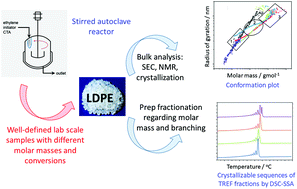Linking molecular structure to plant conditions: advanced analysis of a systematic set of mini-plant scale low density polyethylenes†
Abstract
Two sample sets of low density polyethylene (LDPE) were investigated and differentiated via comprehensive analysis of their microstructures with specific emphasis on branching. The sample sets were produced under well-defined conditions in a high-pressure mini-plant autoclave reactor and vary with respect to molecular weight and conversion. Focus was laid on analyzing the materials with respect to short- and long-chain branching by NMR, light scattering, viscosimetry and crystallization-based methods. Additionally, selected samples were fractionated preparatively. Temperature rising elution fractionation and solvent gradient fractionation were chosen to fractionate the materials according to crystallizability and molecular weight, respectively. Triple detector SEC provided molecular weight distributions, short chain branching densities, Mark–Houwink and conformation plots of the individual preparative fractions. It was proven that the fractionations were successful with regard to the desired properties and a deeper insight into the heterogeneous, complex microstructure of LDPE and its connection to process conditions was obtained.



 Please wait while we load your content...
Please wait while we load your content...